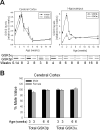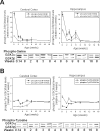Glycogen synthase kinase-3 levels and phosphorylation undergo large fluctuations in mouse brain during development
- PMID: 23167932
- PMCID: PMC3505070
- DOI: 10.1111/bdi.12023
Glycogen synthase kinase-3 levels and phosphorylation undergo large fluctuations in mouse brain during development
Abstract
Objectives: Dysregulated glycogen synthase kinase-3 (GSK3) may contribute to the pathophysiology of mood disorders and other diseases, and appears to be a target of certain therapeutic drugs. The growing recognition of heightened vulnerability during development to many psychiatric diseases, including mood disorders, led us to test if there are developmental changes in mouse brain GSK3 and its regulation by phosphorylation and by therapeutic drugs.
Methods: GSK3 levels and phosphorylation were measured at seven ages of development in the mouse cerebral cortex and hippocampus.
Results: Two periods of rapid transitions in GSK3 levels were identified: a large rise between postnatal days 1 and 2 and three weeks of age, where GSK3 levels were as much as fourfold higher than adult mouse brain levels, and a rapid decline between 2-4 and eight weeks of age, when adult levels were reached. Inhibitory serine-phosphorylation of GSK3, particularly GSK3β, was extremely high in the one-day postnatal mouse brain, and rapidly declined thereafter. These developmental changes in GSK3 were equivalent in the male and female cerebral cortex, and differed from other signaling kinases, including Akt, extracellular-regulated kinases 1/2, c-Jun N-terminal kinase, and p38 levels and phosphorylation. In contrast to the adult mouse brain, where administration of lithium or fluoxetine rapidly and robustly increased serine-phosphorylation of GSK3, in young mice these responses were blunted or absent.
Conclusions: High brain levels of GSK3 and large fluctuations in its levels and phosphorylation in the juvenile and adolescent mouse brain raise the possibility that they may contribute to destabilized mood regulation induced by environmental and genetic factors.
© 2012 John Wiley and Sons A/S.
Figures







Similar articles
-
Blocked inhibitory serine-phosphorylation of glycogen synthase kinase-3alpha/beta impairs in vivo neural precursor cell proliferation.Biol Psychiatry. 2009 Sep 1;66(5):494-502. doi: 10.1016/j.biopsych.2009.04.015. Epub 2009 Jun 11. Biol Psychiatry. 2009. PMID: 19520363 Free PMC article.
-
Brain region differences in regulation of Akt and GSK3 by chronic stimulant administration in mice.Cell Signal. 2012 Jul;24(7):1398-405. doi: 10.1016/j.cellsig.2012.03.001. Epub 2012 Mar 10. Cell Signal. 2012. PMID: 22434044 Free PMC article.
-
Functional significance of glycogen synthase kinase-3 regulation by serotonin.Cell Signal. 2012 Jan;24(1):265-71. doi: 10.1016/j.cellsig.2011.09.009. Epub 2011 Sep 17. Cell Signal. 2012. PMID: 21946431 Free PMC article.
-
Is glycogen synthase kinase-3 a central modulator in mood regulation?Neuropsychopharmacology. 2010 Oct;35(11):2143-54. doi: 10.1038/npp.2010.105. Epub 2010 Jul 28. Neuropsychopharmacology. 2010. PMID: 20668436 Free PMC article. Review.
-
GSK3 and its interactions with the PI3K/AKT/mTOR signalling network.Adv Biol Regul. 2017 Aug;65:5-15. doi: 10.1016/j.jbior.2017.06.003. Epub 2017 Jun 27. Adv Biol Regul. 2017. PMID: 28712664 Review.
Cited by
-
GSK3β: a plausible mechanism of cognitive and hippocampal changes induced by erythropoietin treatment in mood disorders?Transl Psychiatry. 2018 Oct 11;8(1):216. doi: 10.1038/s41398-018-0270-z. Transl Psychiatry. 2018. PMID: 30310078 Free PMC article. Review.
-
A Genetic Model of Epilepsy with a Partial Alzheimer's Disease-Like Phenotype and Central Insulin Resistance.Mol Neurobiol. 2022 Jun;59(6):3721-3737. doi: 10.1007/s12035-022-02810-w. Epub 2022 Apr 4. Mol Neurobiol. 2022. PMID: 35378696
-
Capillary Isoelectric Focusing of Akt Isoforms Identifies Highly Dynamic Phosphorylation in Neuronal Cells and Brain Tissue.J Biol Chem. 2016 May 6;291(19):10239-51. doi: 10.1074/jbc.M115.700138. Epub 2016 Mar 4. J Biol Chem. 2016. PMID: 26945062 Free PMC article.
-
GSK-3β Allosteric Inhibition: A Dead End or a New Pharmacological Frontier?Int J Mol Sci. 2023 Apr 19;24(8):7541. doi: 10.3390/ijms24087541. Int J Mol Sci. 2023. PMID: 37108703 Free PMC article. Review.
-
Synaptic-dependent developmental dysconnectivity in 22q11.2 deletion syndrome.bioRxiv [Preprint]. 2024 Apr 3:2024.03.29.587339. doi: 10.1101/2024.03.29.587339. bioRxiv. 2024. PMID: 38585897 Free PMC article. Preprint.
References
-
- Kessler RC, Berglund P, Demler O, Jin R, Merikangas KR, Walters EE. Lifetime prevalence and age-of-onset distributions of DSM-IV disorders in the National Comorbidity Survey Replication. Arch Gen Psychiatry. 2005;62:593–602. - PubMed
-
- Moreno C, Laje G, Blanco C, Jiang H, Schmidt AB, Olfson M. National trends in the outpatient diagnosis and treatment of bipolar disorder in youth. Arch Gen Psychiatry. 2007;64:1032–1039. - PubMed
-
- Andersen SL, Teicher MH. Stress, sensitive periods and maturational events in adolescent depression. Trends Neurosci. 2008;31:183–191. - PubMed
-
- Grimes CA, Jope RS. The multi-faceted roles of glycogen synthase kinase-3β in cellular signaling. Prog Neurobiology. 2001;65:391–426. - PubMed
Publication types
MeSH terms
Substances
Grants and funding
LinkOut - more resources
Full Text Sources
Research Materials
Miscellaneous

